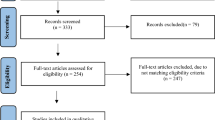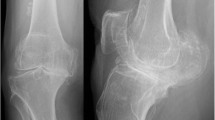Abstract
Introduction
The Mako robotic arm knee arthroplasty system was initially indicated in unicompartmental knee arthroplasty followed by bicompartmental and total knee arthroplasty techniques. The system utilizes three elements: (1) Pre-op 3D CT based planning and image based intra-op navigation. (2) Pre-resection implant modifications with integrated alignment, implant position and gap data, and (3) A semi-constrained robotic arm assisted execution of bone resection with “haptic” boundaries, and cemented implants.
Materials and methods
This paper evaluates variable pre-op implant placement, and anatomic reference positioning; data entry with incorporation of alignment, implant congruency through range of motion, and gaps; bone resection with “haptic” boundaries, and final implant evaluation with kinetic sensors.
Results
The Mako system allowed for improved implant placement utilizing CT guidance, bone resection accuracy, flexibility for functional implant placement with gap balancing. When combined with kinetic sensors, there was improved rotation and soft tissue balance.
Conclusion
The MAKO robotic system can assist the surgeon with anatomic landmarks, provides the flexibility for independent gap balance through implant and alignment refinement, and three-dimensional soft tissue balancing data to achieve functional stability. Registry data has shown improved outcome survivorship irrespective of the surgeons’ volumes and learning curves.



Similar content being viewed by others
References
Citak M, Suero EM, Citak M et al (2013) Unicompartmental knee arthroplasty: is robotic technology more accurate than conventional technique? Knee 20(4):268–271
Dunbar NJ, Roche MW, Park BH, Branch SH, Conditt MA, Banks SA (2012) Accuracy of dynamic tactile-guided unicompartmental knee arthroplasty. J Arthroplasty 27(5):803-808.e1
Hampp EL, Chughtai M, Scholl LY, Sodhi N, Bhowmik-Stoker M, Jacofsky DJ, et al (2018) Robotic-arm assisted total knee arthroplasty demonstrated greater accuracy and precision to plan compared to manual technique. J Knee Surg
Bell SW, Anthony I, Jones B, MacLean A, Rowe P, Blyth M (2016) Improved accuracy of component positioning with robotic-assisted unicompartmental knee arthroplasty: data from a prospective, randomized controlled study. J Bone Jt Surg Am 98(8):627–635. https://doi.org/10.2106/JBJS.15.00664
Roche M (2015) Robotic-assisted unicompartmental knee arthroplasty: the MAKO experience. Orthop Clin N Am 46(1):125–131. https://doi.org/10.1016/j.ocl.2014.09.008 (PMID: 25435041)
Kazarian GS, Barrack TN, Okafor L, Barrack RL, Nunley RM, Lawrie CM (2020) High prevalence of radiographic outliers and revisions with unicompartmental knee arthroplasty. J Bone Jt Surg Am 15:14. https://doi.org/10.2106/JBJS.19.01277 (Published online May 8)
Chatellard R et al (2013) Medial unicompartmental knee arthroplasty: does tibial component position influence clinical outcomes and arthroplasty survival? Orthop Traumatol Surg Res 99:S219
Barbadoro P, Ensini A, Leardini A et al (2014) Tibial component alignment and risk of loosening in unicompartmental knee arthroplasty: a radiographic and radiostereometric study. Knee Surg Sports Traumatol Arthrosc 22(12):3157–3162
Vasso M, Del Regno C, D’Amelio A, Viggiano D, Corona K, Schiavone PA (2015) Minor varus alignment provides better results than neutral alignment in medial UKA. Knee 22(2):117–121
Lonner JH, John TK, Conditt MA (2010) Robotic arm-assisted UKA improves tibial component alignment: a pilot study. Clin Orthop Relat Res 468(01):141–146
Zambianchi F, Daffara V, Franceschi G et al (2020) Robotic arm-assisted unicompartmental knee arthroplasty: high survivorship and good patient-related outcomes at a minimum five years of follow-up. Knee Surg Sports Traumatol Arthrosc
AOANJRR (2021) Australian Registry report 1 September 1999–11 March 2021
Kleeblad LJ, Borus TA, Coon TM, Dounchis J, Nguyen JT, Pearle AD (2018) Midterm survivorship and patient satisfaction of robotic-arm-assisted medial unicompartmental knee arthroplasty: a multicenter study. J Arthroplasty 33(6):1719–1726
Vakharia RM, Law Ty, Roche MW. Survivorship and patient satisfaction rates of robotic-assisted unicompartmental knee arthroplasty. Poster presented at: American Academy of Hip and Knee Surgeons 30th Annual Meeting; November 5-8, 2020; Dallas, Texas.
Fleischman A, Lutz R, Kafshgari HV, Orozco F, Hozack W, Chen A (2018) Time-related learning curve of robotic-arm assisted total knee arthroplasty. In: AAOS; 2018. Annual Meeting
Cheng T, Zhang G, Zhang X. Imageless navigation system does not improve component rotational alignment in total knee arthroplasty. Journal of Surgical Research. 2011;171(2):590-600.
Yau WP et al (2007) Interobserver and intra-observer errors in obtaining visually selected anatomical landmarks during registration process in non–image-based navigation-assisted total knee arthroplasty. J Arthroplasty 22(8):1150–1161
Seidenstein A, et al (2020) Better accuracy and reproducibility of a new robotically-assisted system for total knee arthroplasty compared to conventional instrumentation: a cadaveric study. Knee Surg Sports Traumatol Arthrosc, pp 1–8
Sires JD, Wilson CJ (2020) CT validation of intraoperative implant position and knee alignment as determined by the MAKO total knee arthroplasty system. The J Knee Surg
Roche M, Elson L, Anderson C. Dynamic soft tissue balancing in total knee arthroplasty. Orthopedic Clinics. 2014;45(2):157-65.
Kayani B et al (2018) Iatrogenic bone and soft tissue trauma in robotic-arm assisted total knee arthroplasty compared with conventional jig-based total knee arthroplasty: a prospective cohort study and validation of a new classification system. J Arthroplasty 33(8):2496–2501
Bhimani SJ, Bhimani R, Smith A, Eccles C, Smith L, Malkani A (2020) Robotic- assisted total knee arthroplasty demonstrates decreased postoperative pain and opioid usage compared to conventional total knee arthroplasty. Bone Jt Open 1(2)
Sultan AA et al (2017) Utilization of robotic-arm assisted total knee arthroplasty for soft tissue protection. Expert Rev Med Dev 14(12):925–927
Khlopas A, Chughtai M, Hampp EL, Scholl LY, Prieto M, Chang TC, Abbasi A, Bhowmik-Stoker M, Otto J, Jacofsky DJ, Mont MA. Robotic-Arm Assisted Total Knee Arthroplasty Demonstrated Soft Tissue Protection. Surgical technology international. 2017;30:441-6.
Golladay GJ et al (2019) Are patients more satisfied with a balanced total knee arthroplasty? J Arthroplasty 34(7):S195–S200
Emodi GJ et al (1999) Posterior cruciate ligament function following total knee arthroplasty: the effect of joint line elevation. Iowa Orthop J 19:82
Geller JA, Lakra A, Murtaugh T (2017) The use of electronic sensor device to augment ligament balancing leads to a lower rate of arthrofibrosis after total knee arthroplasty. J Arthroplasty 32(5):1502–1504
Moore RE et al (2021) How to quantitatively balance a total knee? A surgical algorithm to assure balance and control alignment. Sensors 21(3):700
Marchand RC, Sodhi N, Khlopas A, Sultan AA, Harwin SF, Malkani AL et al (2017) Patient satisfaction outcomes after robotic arm-assisted total knee arthroplasty: a short-term evaluation. J Knee Surg 30:849e53. https://doi.org/10.1055/s-0037-1607450
Marchand RC, Sodhi N, Anis HK et al (2019) One-year patient outcomes for robotic-arm-assisted versus manual total knee arthroplasty. J Knee Surg 32:1063–1068
Liow MHL, Goh GSH, Wong MK, Chin PL, Tay DKJ, Yeo SJ (2017) Robotic-assisted total knee arthroplasty may lead to improvement in quality-of-life measures: a 2- year follow-up of a prospective randomized trial. Knee Surg Sports Traumatol Arthrosc 25:2942e51. https://doi.org/10.1007/s00167-016-4076-3
Kayani B et al (2018) Robotic-arm assisted total knee arthroplasty is associated with improved early functional recovery and reduced time to hospital discharge compared with conventional jig-based total knee arthroplasty: a prospective cohort study. Bone Jt J 100(7):930–937
Mont MA, Cool C, Gregory D, Coppolecchia A, Sodhi N, Jacofsky DJ (2019) Health care utilization and payer cost analysis of robotic arm assisted total knee arthroplasty at 30, 60, and 90 days. J Knee Surg
Cool CL, Jacofsky DJ, Seeger KA, Sodhi N, Mont MA (2019) A 90-day episode-of-care cost analysis of robotic-arm assisted total knee arthroplasty. J Comp Eff Res 8:327–336
Pierce J, Needham K, Adams C, Coppolecchia A, Lavernia C (2020) Robotic assisted total knee surgery: an economic analysis, orthopedic research Society Annual Meeting, Feb. 7–11, 2020, Phoenix AZ
Roche et.al. (2021) 10 year Robotic Assisted Medial Unicompartmental Survival and Satisfication, Closed Knee Society Meeting Sept 10th 2021 Napa, California
Author information
Authors and Affiliations
Corresponding author
Ethics declarations
Conflict of interest
Stryker Paid Consultant.
Research involving human participants and/or animals
Not applicable.
Informed consent
Not applicable.
Additional information
Publisher's Note
Springer Nature remains neutral with regard to jurisdictional claims in published maps and institutional affiliations.




